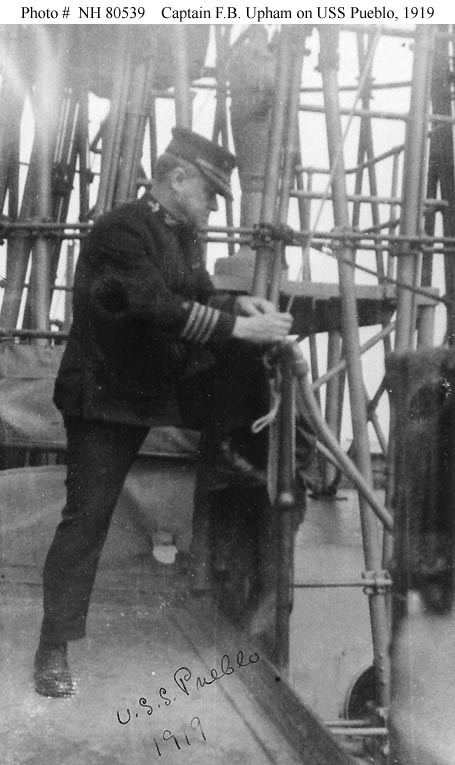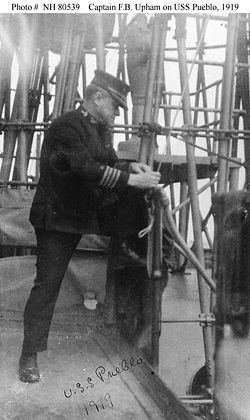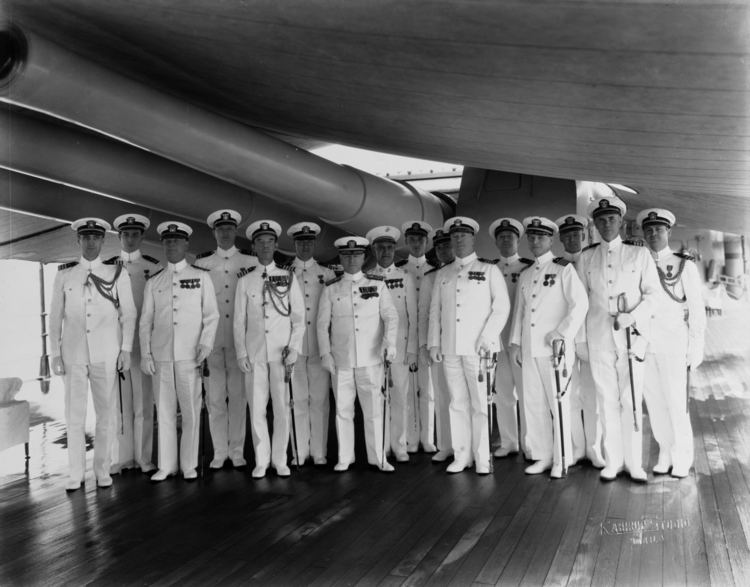Awards Navy Cross Name Frank Upham | Rank Admiral Years of service 1893-1936 | |
 | ||
Born September 7, 1872Fort Apache, Arizona ( 1872-09-07 ) Allegiance United States of America Commands held USS ColumbiaUSS PuebloUSS TennesseeBattleship Division 3Chief, Bureau of NavigationAsiatic Fleet Battles/wars Spanish American WarWorld War I Died September 15, 1939, San Francisco, California, United States Battles and wars | ||
Frank Brooks Upham (7 September 1872 – 15 September 1939) served in the United States Navy during the Spanish American War and was an admiral in the during World War I.
Contents

Biography

Born at Fort Apache, Arizona, Upham was appointed to the United States Naval Academy on 6 September 1889 and graduated on 2 June 1893. Following the completion of the two required years of postgraduate sea duty—which he served with the Pacific Squadron in the protected cruiser Philadelphia—Upham was commissioned an ensign on 1 July 1895 and joined the protected cruiser Olympia on 18 July before she sailed for the Far East to become the flagship of the Asiatic Squadron. At the time of the Spanish-American War, Upham was on the staff of the Commander in Chief, Asiatic Squadron, Commodore George Dewey; and the young officer received his baptism of fire during the Battle of Manila Bay.
He advanced up the officer ranks of the Navy, eventually attaining flag rank in 1927. During the years before World War I, Upham's sea duty embraced tours in the battleships Oregon, New Jersey, and South Dakota; he also commanded Olympia and the yacht Scorpion. He served tours of duty ashore at Newport, Rhode Island, at the Naval War College and in Washington at the Bureau of Ordnance. His overseas shore duty began in the summer of 1911, when he took up the duties of Assistant Naval Attache at Tokyo and Peking, shortly before the outbreak of the Chinese Revolution in October of that year.
During World War I, Upham commanded the cruisers Columbia and Pueblo and earned the Navy Cross for leading the latter during the "difficult, exacting, and hazardous" convoy escort missions across the Atlantic.
In the years following the armistice, Capt. Upham was Chief of Staff to the Commander, Battleship Force, Atlantic Fleet—Rear Admiral Hilary P. Jones—before serving successive tours of shore duty: in Paris as naval attache and in Washington assigned to the Office of Naval Intelligence. He commanded the battleship Tennessee from September 1924-March 1926 and subsequently filled the billet of commandant of the naval air station at Pensacola, Florida. He capitalized on this assignment to earn his naval aviation observer's wings. Reaching flag rank in June 1927, Upham successively commanded Battleship Division 3 and Submarine Divisions, Control Force, and served as Chief of the Bureau of Navigation.
Given the temporary rank of admiral on 18 August 1933, Upham returned to the Far East as Commander in Chief, Asiatic Fleet, and broke his flag in the heavy cruiser Augusta commanded by then-Capt. Chester W. Nimitz. Relieved by Admiral Orin G. Murfin in October 1935, Upham returned to the U.S. to serve as chairman of the General Board from 20 December 1935 – 30 September 1936.
Placed on the retired list on 1 October 1936, Rear Admiral Upham died in San Francisco, California.
